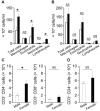CD8+ T Cells Mediate Female-Dominant IL-4 Production and Airway Inflammation in Allergic Asthma
- PMID: 26488300
- PMCID: PMC4619475
- DOI: 10.1371/journal.pone.0140808
CD8+ T Cells Mediate Female-Dominant IL-4 Production and Airway Inflammation in Allergic Asthma
Abstract
The prevalence and severity of bronchial asthma are higher in females than in males after puberty. Although antigen-specific CD8+ T cells play an important role in the development of asthma through their suppressive effect on cytokine production, the contribution of CD8+ T cells to sex differences in asthmatic responses remains unclear. In the present study, we investigated the sex-specific effect of CD8+ T cells in the suppression of asthma using an ovalbumin mouse model of asthma. The number of inflammatory cells in bronchoalveolar lavage (BAL) fluid, lung type 2 T-helper cytokine levels, and interleukin-4 (IL-4) production by bronchial lymph node cells were significantly higher in female wild-type (WT) mice compared with male mice, whereas no such sex differences were observed between male and female cd8α-disrupted mice. The adaptive transfer of male, but not female, CD8+ T cells reduced the number of inflammatory cells in the recovered BAL fluid of male recipient mice, while no such sex difference in the suppressive activity of CD8+ T cells was observed in female recipient mice. Male CD8+ T cells produced higher levels of IFN-γ than female CD8+ T cells did, and this trend was associated with reduced IL-4 production by male, but not female, CD4+ T cells. Interestingly, IFN-γ receptor expression on CD4+ T cells was significantly lower in female mice than in male mice. These results suggest that female-dominant asthmatic responses are orchestrated by the reduced production of IFN-γ by CD8+ T cells and the lower expression of IFN-γ receptor on CD4+ T cells in females compared with males.
Conflict of interest statement
Figures







Similar articles
-
Adoptively transferred late allergic airway responses are associated with Th2-type cytokines in the rat.Am J Respir Cell Mol Biol. 1997 Jan;16(1):69-74. doi: 10.1165/ajrcmb.16.1.8998081. Am J Respir Cell Mol Biol. 1997. PMID: 8998081
-
Interferon-gamma-dependent inhibition of late allergic airway responses and eosinophilia by CD8+ gammadelta T cells.Immunology. 2007 Oct;122(2):230-8. doi: 10.1111/j.1365-2567.2007.02632.x. Immunology. 2007. PMID: 17848163 Free PMC article.
-
Resident CD8+ T cells suppress CD4+ T cell-dependent late allergic airway responses.J Allergy Clin Immunol. 2005 Mar;115(3):521-6. doi: 10.1016/j.jaci.2004.11.036. J Allergy Clin Immunol. 2005. PMID: 15753899
-
The role of Th2 type CD4+ T cells and Th2 type CD8+ T cells in asthma.Immunol Cell Biol. 1996 Apr;74(2):206-8. doi: 10.1038/icb.1996.29. Immunol Cell Biol. 1996. PMID: 8724011 Review.
-
T cells and chronic asthma.Int Arch Allergy Immunol. 1999 Feb-Apr;118(2-4):133-5. doi: 10.1159/000024049. Int Arch Allergy Immunol. 1999. PMID: 10224360 Review.
Cited by
-
Novel Toll-Like Receptor 9 Agonist Derived from Cryptococcus neoformans Attenuates Allergic Inflammation Leading to Asthma Onset in Mice.Int Arch Allergy Immunol. 2020;181(9):651-664. doi: 10.1159/000508535. Epub 2020 Jun 25. Int Arch Allergy Immunol. 2020. PMID: 32585675 Free PMC article.
-
IL-1β Derived Th17 Immune Responses Are a Critical Factor for Neutrophilic-Eosinophilic Airway Inflammation on Psychological Stress-Induced Immune Tolerance Breakdown in Mice.Int Arch Allergy Immunol. 2023;184(8):797-807. doi: 10.1159/000529108. Epub 2023 May 23. Int Arch Allergy Immunol. 2023. PMID: 37231861 Free PMC article.
-
T-cell responses in asthma exacerbations.Ann Allergy Asthma Immunol. 2022 Dec;129(6):709-718. doi: 10.1016/j.anai.2022.07.027. Epub 2022 Jul 30. Ann Allergy Asthma Immunol. 2022. PMID: 35918022 Free PMC article. Review.
-
The Cell Research Trends of Asthma: A Stem Frequency Analysis of the Literature.J Healthc Eng. 2018 Aug 23;2018:9363820. doi: 10.1155/2018/9363820. eCollection 2018. J Healthc Eng. 2018. PMID: 30210753 Free PMC article.
-
Sex Plays a Multifaceted Role in Asthma Pathogenesis.Biomolecules. 2022 Apr 29;12(5):650. doi: 10.3390/biom12050650. Biomolecules. 2022. PMID: 35625578 Free PMC article. Review.
References
-
- Moorman JE, Akinbami LJ, Bailey CM, Zahran HS, King ME, Johnson CA, et al. National surveillance of asthma: United States, 2001–2010. Vital Health Stat 3. 2012; 35: 1–67. - PubMed
-
- Pérez-Perdomo R, Pérez-Cardona C, Disdier-Flores O, Cintrón Y. Prevalence and correlates of asthma in the Puerto Rican population: Behavioral Risk Factor Surveillance System, 2000. J Asthma. 2003;40: 465–474. - PubMed
-
- Akinbami LJ, Moorman JE, Bailey C, Zahran HS, King M, Johnson CA, et al. Trends in asthma prevalence, health care use, and mortality in the United States, 2001–2010. NCHS Data Brief. 2012;94: 1–8. - PubMed
-
- Moorman JE, Person CJ, Zahran HS; Centers for Disease Control and Prevention (CDC). Asthma attacks among persons with current asthma—United States, 2001–2010. MMWR Surveill Summ. 2013;62: 93–98. - PubMed
Publication types
MeSH terms
Substances
LinkOut - more resources
Full Text Sources
Other Literature Sources
Medical
Research Materials

